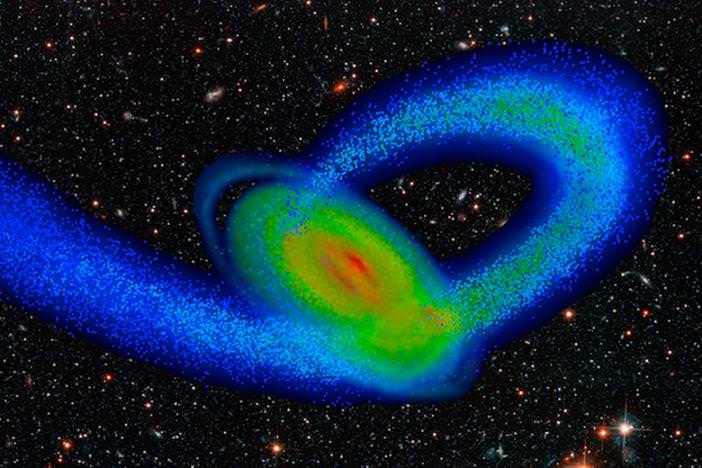[/caption]
For a good number of years, astronomers have hypothesized the Sagittarius Dwarf Galaxy has been loaded up with dark matter. As one of our nearest neighboring galaxies and part of our local group, Sag DEG has been hanging around for billions of years and may have orbited us as many as ten times. However, in order to survive the tidal strain of such interaction, this loop-shaped elliptical has got to have some muscle. Now UC Irvine astronomers are speculating on how these close encounters may have shaped the Milky Way’s spiral arms.
In a study released in today’s Nature publication, astronomers are citing telescopic data and computer modeling to show how our local galactic collision has sent streams of stars out in loops in both galaxies. These long streamers continue to collect stellar members and the rotation of the Milky Way forms them into our classic spiral pattern. The news is the presence of dark matter in Sag DEG is responsible for the initial push.
“It’s kind of like putting a fist into a bathtub of water as opposed to your little finger,” said James Bullock, a theoretical cosmologist who studies galaxy formation.
But the little Sagittarius Dwarf, as strong as the dark matter might be, isn’t going to win this cosmic arm wrestling match. Each time we interact, the small galaxy gets further torn apart and about all that’s left is four globular clusters and a smattering of old stars which spans roughly 10,000 light-years in diameter.
“When all that dark matter first smacked into the Milky Way, 80 percent to 90 percent of it was stripped off,” explained lead author Chris Purcell, who did the work with Bullock at UCI and is now at the University of Pittsburgh. “That first impact triggered instabilities that were amplified, and quickly formed spiral arms and associated ring-like structures in the outskirts of our galaxy.”
Will we meet again? Yes. The Sagittarius galaxy is due to strike the southern face of the Milky Way disk fairly soon, Purcell said – in another 10 million years or so.
Original Story Source: University of Irvine News. Further Reading: The Sagittarius impact as an architect of spirality and outer rings in the Milky Way.


Yo Tammy, at the footnote, what do you mean by “Futher” reading? 😉
Maybe something like this: http://arxiv.org/ftp/arxiv/papers/1109/1109.2918.pdf
Obviously, I didn’t dig deep enough on this occasion!
This seems to be a new physical theory for the origin of spiral structure in galaxies.
LC
Awesome, But unfortunately we are unable to see any of it, the loops or anything else.
While not visible to the naked eye, astronomers have detected features known as the Sagittarius Stream and the Monoceros Ring, thought to be related to the Sagittarius Dwarf Elliptical Galaxy.
Why? We see stars, gas and dark matter everywhere else, by light and gravitational effects on light. What would make this any different?
“astronomers are citing telescopic data”.
Indeed, the Nature article part that is outside of the paywall:
“Combining this with observational constraints on the dispersion (????10–15?km?s?1), breadth (8–10?kpc; ref. 27), and length of the observed debris stream provides some legitimacy for our model.”
“The corresponding high-latitude arc in our simulation at that distance is composed of stars that were initially widely distributed throughout the disk, suggesting that radial mixing during the Sgr impact must be an important factor in the Milky Way’s recent chemodynamical evolution, and also that the chemical composition of the real Monoceros ring feature may not be as reliable in discriminating models for the origin of the ring as otherwise expected. See the Supplementary Information, in which we discuss the quantitative agreement between our Galactic anti-Centre spiral structure and Monoceros ring observations in more detail.”
I find it helpful to read George Gamow Our Star the Sun, when words like ‘dark matter’ and ‘dark energy’ arise. Currently physics recognizes that mass is what happens when acceleration to maximum occurs like in a particle accelerator. So the ‘mass’ of Sagittarius is now residing in the ‘halo’ outside of the equatorial region of the Milky Way. And the matter is attached as an arm that centers a Birkeland current spiraling up the arm the the Milky Way center.
Atoms ‘broken’ become free electrons and free nuclei. Under compression this free gas can ultimately become a nuclear fluid according to this major physicist.